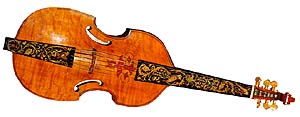 The viol is a family of bowed instruments widely used in the 16th and 17th centuries, both for solo and ensemble playing. Wide variations of size, tuning, and shape among viols is common. The bass viol often served as contiuno, and was long preferred to the cello for that important function, whereas the treble viol, tuned an octave higher and capable of great resonance, excelled in polyphonic music. Viols are ideal for expressive playing; the sound of many can closely imitate the timbre of the human voice. The viol's characteristic playing position—between the legs, in the same way a modern cello is played—probably originates in 11th century Europe, and the instrument itself first appeared in Italian paintings of the 15th century.
The viol is a family of bowed instruments widely used in the 16th and 17th centuries, both for solo and ensemble playing. Wide variations of size, tuning, and shape among viols is common. The bass viol often served as contiuno, and was long preferred to the cello for that important function, whereas the treble viol, tuned an octave higher and capable of great resonance, excelled in polyphonic music. Viols are ideal for expressive playing; the sound of many can closely imitate the timbre of the human voice. The viol's characteristic playing position—between the legs, in the same way a modern cello is played—probably originates in 11th century Europe, and the instrument itself first appeared in Italian paintings of the 15th century.

Larry Lipkis plays viols, recorder, and crumhorn for the consort. He is Composer-in-residence and associate professor of music at Moravian College in Bethlehem, Pennsylvania, where he also directs the early music program. A recording of his cello concerto, Scaramouche, was recently released on the Koch label, and a companion work, Harlequin, for bass trombone and orchestra, will be premiered next may by the Los Angeles Philharmonic.






